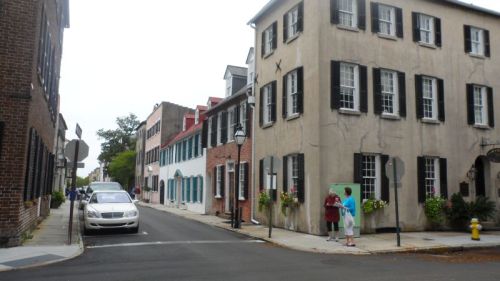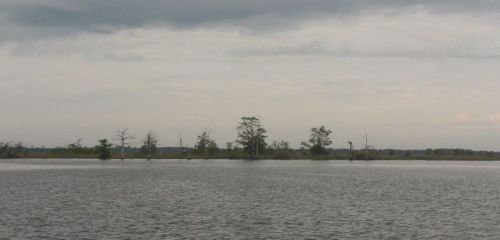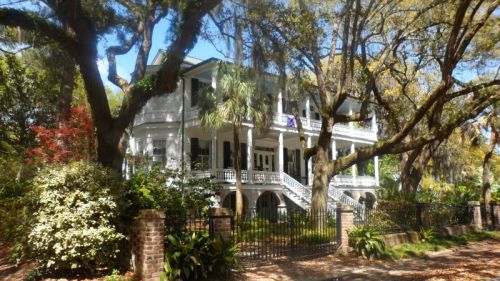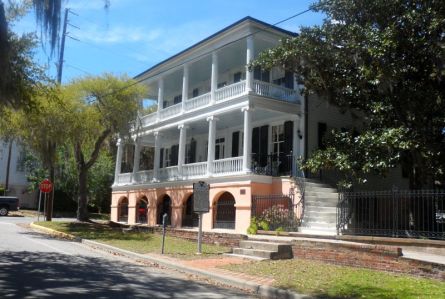To call yourself an American Tourist, there are six, “must see” cities — San Francisco, New York, Washington, Chicago, New Orleans and Charlestown, SC. (LA is number 113 and Houston is 247). If there’s only one trip in your life that you make to the South, it HAS to be Charleston.
I first came here in 1977 and once you got north of the famous Battery (huge antebellum mansions along the waterfront)things were still pretty tough. But the preservation effort since Hurricane Hugo has been really remarkable, even more so because so much of it has been done by private individuals. These folks take phenomenal care of their homes, don’t seem to mind us history/architecture buffs poking around, and put up with all kinds of restrictions in the name of preservation.
For kids, the story of Charleston as the focal point of the Civil War and the wonderful presentation by the National Parks Service at Fort Sumter is reason enough to come, and the nearby beaches are pristine. But I’ve been there and done that, and this trip I had the time to really wallow in the past, the craftsmanship and the patina of this gem.
I spent three days wandering, two under the guidance of the Historic Charleston Foundation. The long walking tour was led by a real Charleston belle — grew up in a mansion on the Battery, made her debut at the Carolina Assembly, a member of the Carolina Yacht Club (when it was “the only decent place to eat in town”) and tried to be polite to Yankees in her references to the War Between the States. She is also a member of St. Michaels Episcopal Church so she took us down the alley and into a side door for a look at the magnificent carving on the pulpit and Tiffany stained glass. My other Foundation day was with a docent at the Nathaniel Russell House, who liked questions and had all her facts and furniture down cold.
Many historic homes have distinguished exteriors and wonderful furnishings, but the decoration is sometimes pretty simple, since we are a relatively new society and their owners were often merchant pioneers to begin with. The Russell house is an exception — magnificently detailed from top to bottom with some of the finest faux finishes and carving I’ve ever seen. You see a lot of fancy stuff in Newport and New York, but a lot of it is plaster casting or shipped in room-by-room from Europe. The Russell work was done locally from 1803 to 1808, much of it by slaves. To the Foundation’s credit, they have tried to find out and present as much detail about the slaves who built, lived in and cared for the house as they do about the Russell family who owned them.
I wondered how I was going to relate my experiences in pictures, since one great old house is pretty much the same as another in a blog. So as I was I thought it might be more meaningful to show pictures from just one random street of a half-dozen running off the Battery — Church Street. It took me four hours to cover four blocks.
John is back and we hope to get out of here tomorrow, but the weather has been atrocious, and it looks doubtful. As much as I love Charleston, I am really tired of Charleston City Marina, since we are parked on the Mega Dock with all the huge yachts. It was fun at first, but the Mega Dock is a quarter of a mile long, so a half mile round trip for a shower or ice wears pretty thin after a week’s stay.

Church Street. My favorite, but a half-dozen others that are just as interesting.

Perfect example of a wood “single house” — one room wide front to back. The entrance you see is just to the street and comes onto the veranda. The main entrance to the house is off the veranda.

Free-standing Palladian that used to be a row house until it’s neighbor burned down.

Brick single house.

Brick “double house” — two rooms wide.

Nice little Church Street Victorian.

Very early row houses (1740) on Tradd Street running into Church.

“Hypen” Neo-Classical. The section to the left was originally the kitchen, totally separated from the main house. As the fire situation improved, the sections were joined in the middle with the “hyphen.”

Double house, but instead of being a traditional Georgian it has the practical Charleston verandas on the side.

Antebellum mansion at Church and Battery that has just been bought by a young couple for $3 million with many more to go in restoration. Good for them. See the pink bow in the middle? They just had a baby girl. I believe that’s her Porsche.

Neo-Classical mansion on the Battery. I believe this one was built for a cotton planter’s daughter, but then again I think most of them were. This is what the tourist’s come to see, but the preserved area run’s miles north of the Battery and is beautiful in a much lower-key way.

Many of the single houses have elaborate small gardens facing the verandas.

Nathaniel Russell House.

Side view of the Russell house. It’s an Adam — you can tell by the pediments over the windows and the curved rooms. After looking at historical houses for a year, this stuff is all starting to sort itself out.

Russell House flying staircase. Don’t have a good picture, but it weaves it’s way around majestically for four stories.

Russell House drawing room.

Slave quarters at Russell House. I think the correct terminology is “enslaved persons” — that’s the term the docents use.

The mahogany pulpit at St. Michaels.

- Hall where our tour guide made her debut at the Carolina Assembly. I am so old I actually attended a white tie debutante ball — with a young lady from South Carolina.

The Mega Dock — Memsahib is lost in the diminishing perspective way down at the end.

The mega dock. The midget standing by this little number is John.




















































































